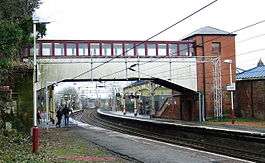Port Glasgow railway station
| Port Glasgow | |
|---|---|
|
Trainspotters turn out to see a special train at Port Glasgow | |
| Location | |
| Place | Port Glasgow |
| Local authority | Inverclyde |
| Coordinates | 55°56′01″N 4°41′25″W / 55.9335°N 4.6902°WCoordinates: 55°56′01″N 4°41′25″W / 55.9335°N 4.6902°W |
| Grid reference | NS320744 |
| Operations | |
| Station code | PTG |
| Managed by | Abellio ScotRail |
| Number of platforms | 2 |
|
Live arrivals/departures, station information and onward connections from National Rail Enquiries | |
| Annual rail passenger usage* | |
| 2004/05 | 0.379 million |
| 2005/06 |
|
| 2006/07 |
|
| 2007/08 |
|
| 2008/09 |
|
| 2009/10 |
|
| 2010/11 |
|
| 2011/12 |
|
| 2012/13 |
|
| 2013/14 |
|
| History | |
| 1841 | Opened |
| National Rail – UK railway stations | |
| * Annual estimated passenger usage based on sales of tickets in stated financial year(s) which end or originate at Port Glasgow from Office of Rail and Road statistics. Methodology may vary year on year. | |
|
| |
Port Glasgow railway station is on the Inverclyde Line, serving the town of Port Glasgow, Scotland. It is located in the town centre with the main entrance at the junction of Princes Street and John Wood Street.
It dates from March 1841, being one of the intermediate stations on the Glasgow, Paisley and Greenock Railway which opened on that date.[1] It later became a junction in 1865, when the branch to Wemyss Bay was opened. The main line was then extended to Gourock in 1889 by the Caledonian Railway.
The two lines diverge to the west of the station, with the Wemyss Bay branch now mostly single track all the way to the terminus; the Gourock line is double throughout. Both lines were electrified in 1967 by British Rail using the 25kV A.C system, with the branch partially singled as part of the modernisation work. A (now disused) connection to the former Glasgow and South Western Railway station at Greenock diverged from the branch line a short distance west of the junction. The old station was used for a period (circa 1971-84) as a container terminal, but was officially closed in September 1991.[2]
There was a bay platform at the west end of the station for services to Wemyss Bay. The platform was located on the south side of the line and is now infilled - prior to electrification, it was used for carriages which were added to (and on return detached from) Wemyss Bay trains.
Services
There are five trains per hour from the station eastbound on weekday & Saturday daytimes to Paisley & Glasgow Central - four originate from Gourock and one from Wemyss Bay. Three of these are limited stop (including that from Wemyss Bay) , whilst the others call at all intermediate stations en-route. Westbound, the same frequency operates - hourly to Wemyss Bay calling all all intermediate stations, 2 per hour fast to Greenock Central and then all stations to Gourock and 2 per hour that stop at all stations to Gourock. In the evening, there are two trains per hour to Gourock, one to Wemyss Bay and three to Glasgow Central, whilst on Sundays there is a half-hourly service to Glasgow and hourly to both Gourock & Wemyss Bay.[3] Most trains are now operated by Class 380 EMUs, though Class 314 units have been used on occasions.
Gallery
.jpg) A ten-coach enthusiasts' special passing through Port Glasgow station. The rear loco carried a plate bearing "Pathfinder Tours". Such trains are not a common sight on this line. St Andrews church can be seen in the background.
A ten-coach enthusiasts' special passing through Port Glasgow station. The rear loco carried a plate bearing "Pathfinder Tours". Such trains are not a common sight on this line. St Andrews church can be seen in the background..jpg) Covered walkway leading from the main station entrance on Princes Street to the concourse and ticket office
Covered walkway leading from the main station entrance on Princes Street to the concourse and ticket office.jpg) A banner repeater signal on the Glasgow-bound platform
A banner repeater signal on the Glasgow-bound platform
References
- ↑ "Glasgow, Paisley and Greenock Railway" Crawford, E Railscot; Retrieved 2 September 2016
- ↑ "Union Street Tunnel"Forgotten Relics; Retrieved 2 September 2016
- ↑ Table 219 National Rail timetable, May 2016
Sources
- Butt, R. V. J. (1995). The Directory of Railway Stations: details every public and private passenger station, halt, platform and stopping place, past and present (1st ed.). Sparkford: Patrick Stephens Ltd. ISBN 1-8526-0508-1. OCLC 60251199.
- Jowett, Alan (March 1989). Jowett's Railway Atlas of Great Britain and Ireland: From Pre-Grouping to the Present Day (1st ed.). Sparkford: Patrick Stephens Ltd. ISBN 1-8526-0086-1. OCLC 22311137.
| Preceding station | |
Following station | ||
|---|---|---|---|---|
| Bogston | Abellio ScotRail Inverclyde Line (to Gourock) |
Woodhall | ||
| Whinhill | Abellio ScotRail Inverclyde Line (to Wemyss Bay) |
|||
| Historical railways | ||||
| Bogston Line and station open |
Caledonian Railway Glasgow, Paisley and Greenock Railway |
Langbank Line and station open | ||
| Upper Greenock Line open; station closed |
Caledonian Railway Greenock and Wemyss Bay Railway |
connection to Glasgow, Paisley and Greenock Railway | ||
